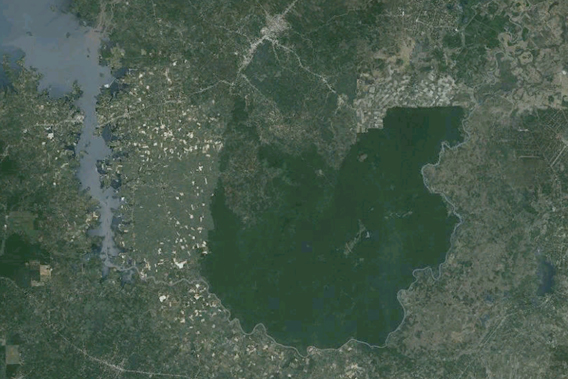Little remains of Vietnam’s primary forest: as of 2005 only 12% of Vietnam forest was classified as primary. While deforestation rates have lessened since the end of the 1990s, survival of species in Vietnam depends in part on secondary, logged, and degraded forests. A new study in mongabay.com’s open access journal Tropical Conservation Science finds that logged forests in southern Vietnam still retain significant biodiversity of trees, including important conservation species, such as Dipterocarp trees.
“Vietnam has to face two major problems, biodiversity conservation and wood supply. […] In this context, the question is how logged forests can participate in biodiversity conservation,” the authors explain. “Logged forests are generally seen as having a much lower conservation value than protected forests. After logging, the species richness is generally reduced and the composition changed in favor of pioneer trees.”
However recent research is beginning to show that logged forests in many tropical areas retain some biodiversity and therefore such forests are possible targets for conservation as well as more rigorous management efforts.
Examining 25 half-hectare plots in Tan Phu Forest—which was heavily logged only 10 years prior—researchers recorded a total of 176 tree species, including 12 species that are considered globally threatened. In addition Tan Phu Forest contains six different types of forest ecosystem, including eight Dipterocarp species, which made up nearly 12% of the trees sampled. In fact, Tan Phu Forest had a higher density of Dipterocarp forests than Cat Tien National Park just to the north. Although Cat Tien, not surprisingly, is more species rich overall than Tan Phu Forest.
“Overall, the logged forest of Tan Phu presents a low species richness when compared with the neighboring protected forest of Cat Tien, but the floristic groups observed often have high species richness and diversity values due to the appearance of many pioneer species,” the authors write.
The conservation importance of Tan Phu Forest in terms of trees rests mostly on its remaining Dipterocarps, according to the study, which notes that a number of Dipterocarp species are even now threatened with local extinction in Tan Phu Forest.
“The logged forest of Tan Phu still has a high conservation value, but urgent action should be undertaken to preserve the conservation species. Two Dipterocarpaceae forests identified in the study should be protected in order to preserve most of the Dipterocarpaceae species. The conservation species closest to extinction should be considered under afforestation programs,” the researchers conclude.

Tan Phu Forest as viewed by Google Earth.
CITATION: Millet, J. and Truong, L. H. 2011. Assessment of the diversity and distribution of the threatened tree species in a logged forest in Vietnam. Tropical Conservation Science Vol. 4 (1):82-96.
Related articles
Illegal logging rampant in Vietnam
(11/01/2010) Illegal logging is rampant in Vietnam, according to a new report from the the Ministry of Agriculture and Rural Development’s General Forestry Department.
Vietnam outsources deforestation to neighboring countries

(09/02/2009) Taking a cue from its much larger neighbor to the north, Vietnam has outsourced deforestation to neighboring countries, according to a new study that quantified the amount of displacement resulting from restrictions on domestic logging. Like China, Vietnam has experienced a resurgence in forest cover over the past twenty years, largely as a result a forestry policies that restricted timber harvesting and encouraged the development of processing industries that turned raw log imports into finished products for export. These measures contributed to a 55 percent of Vietnam’s forests between 1992 and 2005, while bolstering the country’s stunning economic growth. But the environmental benefit of the increase in Vietnam’s forest cover is deceptive: it came at the expense of forests in Laos, Cambodia, and Indonesia. Authors Patrick Meyfroidt and Eric F. Lambin of the Universite Catholique de Louvain in Belgium calculate that 39 percent of Vietnam’s forest regrowth between 1987 and 2006 was effectively logged in other countries. Half of the wood imports into Vietnam were illegal.
Deforestation jumps 55% in Vietnam province
(02/18/2009) Deforestation increased 55 percent during the past year in Vietnam’s Dak Nong province, reports the Vietnam News Agency.